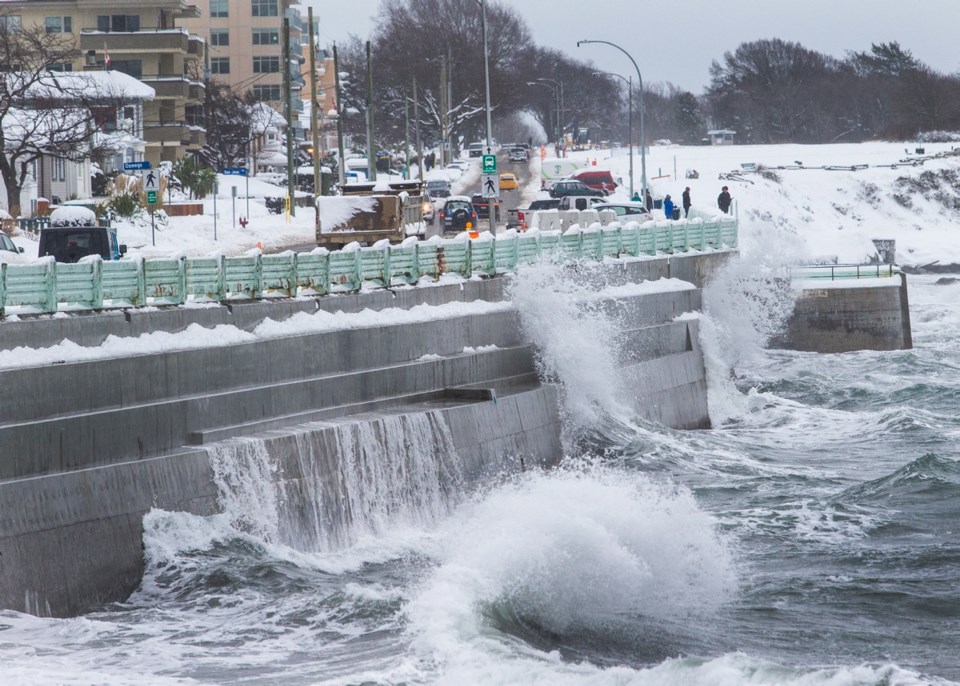A snowstorm blasted through southern Vancouver Island Wednesday, prompting schools and many businesses to close, but it also sent people outside to enjoy the weather by riding toboggans and sliding on skis.
Later in the day, a second storm, this time dominated by wind, hit much of the region.
With forecast wind speeds of 70 to 90 km/h in some areas, B.C. Ferries cancelled all sailings on its major routes, including Victoria-Vancouver, from 3 p.m.
The provincial government issued travel advisories, asking people to avoid travel on many highways because of snow on the ground and blowing snow, and winter-weather warnings were issued for most of the province.
For Greater Victoria, the snow and wind should ease today, with a 40 per cent chance of rain or wet flurries and a daytime high of 4 C. Temperatures are expected to increase on subsequent days, with a high of 5 on Friday, and 8 on Saturday and Sunday.
Environment Canada meteorologist Armel Castellan said the snow total at Victoria International Airport midday on Wednesday was 24 centimetres, before snow started to fall again in the afternoon.
He said he took a range of snow measurements at his Victoria home and found depths of 20 to 28 cm.
“Lake Cowichan was upwards of 36, the same with Cobble Hill,” he said.
Castellan said it was largely the southern third of the Island that got the brunt of the snow.
In Victoria, salt and plenty of it was among the tools the city used to keep traffic moving. On Tuesday and Wednesday, about 200 tonnes of salt was spread on streets, to melt the ice and snow, said Brian Murphy, assistant director of public works.
The city has plenty of salt on hand in case there are more snowstorms.
The process of clearing streets and spreading salt begins with main routes. “During a big snow event, we just have to continue repeating those routes, so it is challenging when that much snow is falling,” he said. “We’re essentially just trying to keep pace.”
Douglas, Government, Bay, Fort and Pandora are among streets at the top of the priority list. Not only do they see the most traffic, but they are emergency routes for ambulances and fire and police vehicles.
“We stay on the main routes until we’re satisfied with the condition of those roads, and then we are able to get into the residential streets next,” he said. Work goes on around the clock, said Murphy, noting crews have been working continuously since Sunday.
While main roads are cleared with dump trucks fitted with snow blades, bike lanes are cleared with a smaller vehicle fitted with a brush.
“We use different equipment and it’s important to understand that one doesn’t take away from the other,” said Murphy, in response to criticism that bikes lanes were cleared before motor-vehicle lanes. “It just comes down to we’re maintaining both at the same time as best we can.”
Because of the difficult road conditions, B.C. Transit buses had to make detours and some trips were cancelled.
Hilly routes serving Otter Point, Triangle Mountain and Emily Carr Drive/Chatterton Way were among those affected. “It’s a constant re-evaluation,” said B.C. Transit spokesman Jonathon Dyck. “Our message to customers is: ‘Please be patient with us and we’re working hard to get you where you need to go safely.’ ”
Traffic on the Malahat was snarled for a period Wednesday afternoon when a southbound tractor-trailer unit slid into a highway divider, then hit a rock face at Finlayson Arm Road. Nobody was hurt in the crash, which was reported to West Shore RCMP about 1:15 p.m.
In Nanaimo, the city was “hammered” with snow from about 4 to 9 a.m. Wednesday, said David Myles, the city’s manager of roads and traffic services, who estimated he had about 30 centimetres in his yard.
Myles said the city’s approach during heavy snowfalls is to divide roads into three levels of priority. Top-priority emergency routes were established through meetings with the fire department, police department and ambulance service a number of years ago, he said.
As in Victoria, Nanaimo crews stay on those routes until they are clear before moving on, Myles said.
Langford director of engineering Michelle Mahovlich said vehicles should be kept in garages or on driveways as much as possible to assist road-clearing crews. It’s especially important when dealing with side roads, she said.
Sidewalks are also a concern, and Mahovlich said Langford has a sidewalk-clearing machine that is being put to good use. “We’re hitting all the major areas that are walkable to amenities, like Goldstream and Langford Parkway and Veterans Memorial Parkway, and over both of the overpasses, Millstream and Leigh.”
In Victoria, residents and business owners are required to clear their walks by 10 a.m. each day, Murphy said.
“We really do depend on residents and businesses taking care of those sidewalks. There are still a lot of pedestrians out and we want them to have safe passage.”
B.C. Hydro reported hundreds of outages on southern Vancouver Island because of the weather. In Greater Victoria, North Saanich and Central were especially hard hit.
The corporation issued this statement: "As snow and strong winds continue, customers currently without power in Jordan River and Galiano Island will be out overnight as current conditions are too dangerous to complete restoration work or are preventing access to these areas. Weather permitting, crews will return the morning of January 16th to restore power to these customers."
— With files from The Canadian Press



